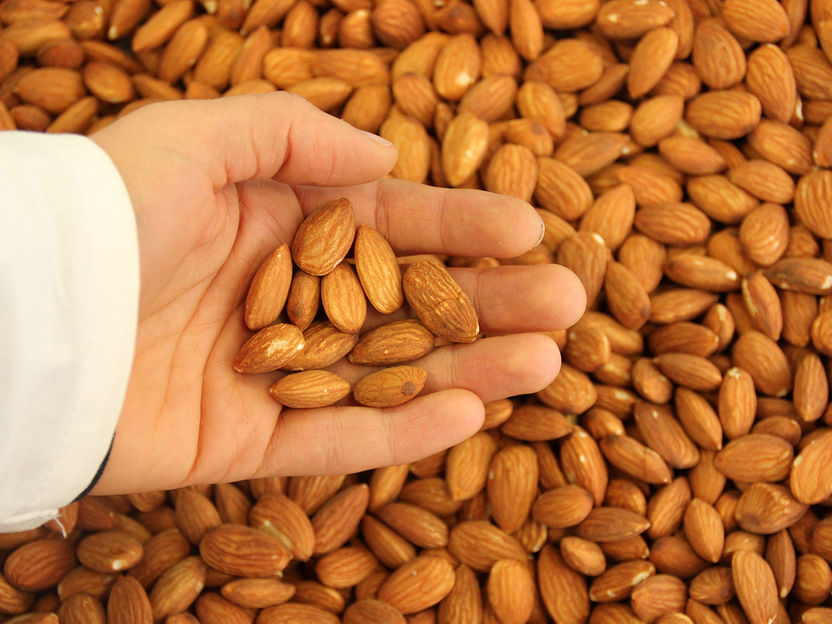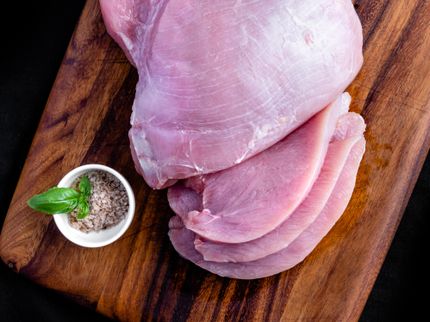Decontamination of almonds
Advertisement
Christmas time is also almond time. Whether in a Christmas biscuit, in a stollen or as a snack for in between - almonds are simply a part of it for many people. In order to ensure a safe consumption of almonds, the Fraunhofer UMSICHT, together with Canadian partners, is developing a process to kill pathogenic microorganisms on the almond kernels.

In North America, almonds must be decontaminated before being placed on the market.
Fraunhofer UMSICHT
According to a study by the World Health Organization, every tenth person suffers from food poisoning once a year, for example caused by pathogenic microorganisms. This means that there are 600 million cases of illness and 420,000 deaths a year worldwide. In addition, in recent years food with low water activity has been increasingly affected by recalls, including almonds. If almonds are contaminated with pathogenic microorganisms, this is done after harvesting, for example with salmonella. Salmonella is transmitted to the almonds through animal or human contact in the processing chain. After serious cases of disease in North America, which were attributed to the consumption of contaminated almond products and the almond product recalls that followed, only almonds that have previously undergone a process that ensures a reduction of salmonella on the almonds by log4 may be traded in North America. Ensuring this salmonella reduction is a prioritised criterion for the food safety of almonds in North America. The Almond Board of California demands an even stronger reduction with log5. To achieve this, the almonds are roasted, steamed or treated with propylene oxide. A new alternative is CO2 decontamination, which is being developed within the framework of the MiDeCO2 project in cooperation with the University of Alberta (Canada).
Advantages of CO2 technology
The MiDeCO2 process uses CO2 to kill microorganisms. CO2 has the particular advantage that it can be separated from the almonds residue-free and recycled after the process.
The two Fraunhofer UMSICHT employees, Karen Fuchs and Anna Oelbermann, attach great importance to the fact that the almonds after treatment in the CO2 process have both the required degree of reduction of log5 and a high product quality that meets the market requirements. This is also the special challenge of MiDeCO2 process management. In the process, CO2 must be able to act on the microorganisms in such a way that they are killed and at the same time interactions between the CO2 and the almond itself must be minimized. The declared goal is for the almonds to have the same product quality after the CO2 process in terms of sensory, physical and chemical attributes as before the process.
First successes with contaminated almonds
Karen Fuchs, who is mainly responsible for the MiDeCO2 process development in the high-pressure pilot plant at UMSICHT, was able to successfully demonstrate on a 1.5L scale that almonds contaminated with Staphylococcus carnosus show a log5 reduction after the MiDeCO2 process. This means that the MiDeCO2 process has the potential to be an alternative to the established decontamination processes. Staphylococcus carnosus can be used as a representative substitute for pathogenic Salmonella in the development of the CO2 process. Michael Gänzle, Feral Temelli and Lynn McMullen from the University of Alberta (Canada) have shown as cooperation partners in the MiDeCO2 research project that Staphylococcus carnosus is similarly resistant to CO2 pressure as a cocktail of five different pathogenic Salmonella and E.coli species. Studies are currently underway to evaluate Mandel product quality according to the MiDeCO2 process. Process validation for salmonella is planned. For example, the almonds treated in the MiDeCO2 process are examined for their rancidity, fat composition and storage stability.
The MiDeCO2 process is to be further developed in the future. "Our process is currently geared to the food safety requirements of the North American market because there is a market for our technology there as a result of the legal framework conditions. At the same time, we are very interested in addressing the European market in further process development. Therefore, our focus in the future will be both on the scale-up of the process and on talking to potential customers from the European food industry in order to better adapt the process to the concrete needs of potential European customers. This can also mean that we are targeting other foods," says Anna Oelbermann from Fraunhofer UMSICHT.
funding reference
The project was funded by the BMBF within the framework of BioeconomyInternational.
Note: This article has been translated using a computer system without human intervention. LUMITOS offers these automatic translations to present a wider range of current news. Since this article has been translated with automatic translation, it is possible that it contains errors in vocabulary, syntax or grammar. The original article in German can be found here.
Other news from the department business & finance
Most read news
More news from our other portals
See the theme worlds for related content
Topic world Food safety
Food safety is at the heart of the food and beverage industry. It ensures that the food we eat every day is not only nutritious, but also free of harmful contaminants. From field to plate, the industry monitors and regulates every step of the process with strict quality controls, advanced testing methods and continuous research.

Topic world Food safety
Food safety is at the heart of the food and beverage industry. It ensures that the food we eat every day is not only nutritious, but also free of harmful contaminants. From field to plate, the industry monitors and regulates every step of the process with strict quality controls, advanced testing methods and continuous research.
























































